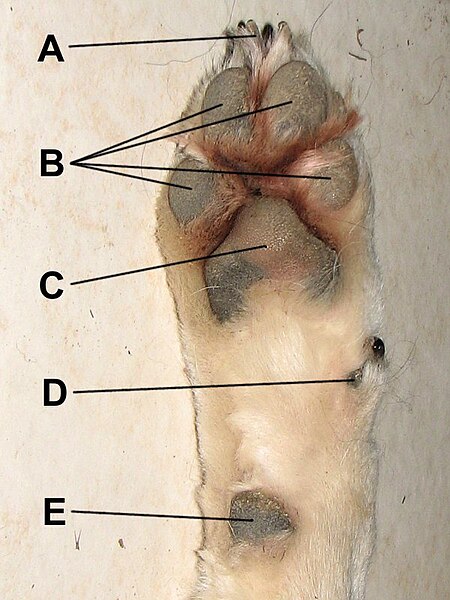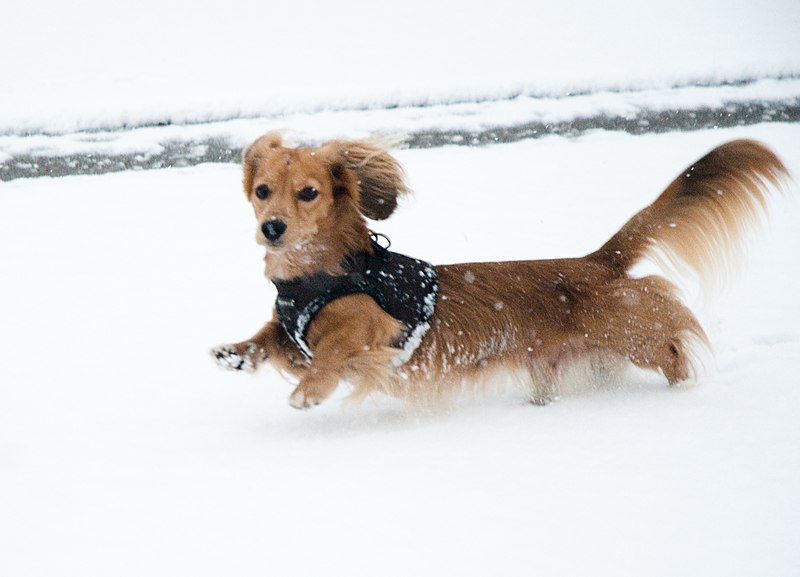 Like the human foot, your dog’s paws are designed by nature to function to protect leg bones and joints from the impact of walking, running, and jumping. The specialized calloused tissue of the pads form a protective barrier against hot and cold and help your dog to grip terrain as they explore. We’re fortunate to have a plethora of shoe styles to protect our feet, and the luxury of going for periodic foot pampering sessions and exams to ensure that our feet can do their job effectively. Did you know that there are lots of easy things you can do at home for your pet to keep his paws in prime condition too? Take a look below to learn some simple ways to keep your pet’s peds happy and healthy year round.
Like the human foot, your dog’s paws are designed by nature to function to protect leg bones and joints from the impact of walking, running, and jumping. The specialized calloused tissue of the pads form a protective barrier against hot and cold and help your dog to grip terrain as they explore. We’re fortunate to have a plethora of shoe styles to protect our feet, and the luxury of going for periodic foot pampering sessions and exams to ensure that our feet can do their job effectively. Did you know that there are lots of easy things you can do at home for your pet to keep his paws in prime condition too? Take a look below to learn some simple ways to keep your pet’s peds happy and healthy year round.
First, you should know a little about your pet’s foot anatomy. These hard working appendages are simple to understand, yet complex in their function. If you take a closer look at the bottom of your dog’s foot, you’ll see the prominent metacarpal(C) and smaller digital pads(B) (the “paw print”), the carpal pad (the knobby, rather rigid pad(E) near your dog’s “wrists”), claws(A), and dew claws(D) (the smaller “thumb” toe and claw. Your dog may have had these removed as a puppy).
Maintenance
Now that you know what you’re looking at, let’s talk about how these little works of art should be maintained. Maintenance of your dog’s paws is much easier if they are used to having their feet handled and worked with. Use caution if your pet doesn’t like his paws handled or isn’t used to these maintenance actions to prevent injury to you or your pet.
You probably know that your dog should have his claws (and dew claw) clipped regularly to maintian the proper length. The frequency fo trimmings can vary depending on the terrain your dog walks on most and the growth rate of his claws in general. Dogs that walk on rough surfaces like concrete or street surfaces may naturally wear the nails down, whereas dogs that spend most of their time on carpet or grass may need more frequent trimmings. If your  pet’s nails are clicking against the floor or getting snagged on things, it’s probably time for a pedicure. You can have your veterinarian or groomer trim the nails or use nail trimmers to do it at home, just be sure you know how to use them properly. The idea is to trim only the hard keratin tip of each claw, and trimming a claw too short may cause you to knick the “quick”, the area where blood flows into the nail. It is especially hard to judge how far to trim on opaque or black claws, and if you can’t judge where the quick begins it may be safer to allow a professional to the job.
pet’s nails are clicking against the floor or getting snagged on things, it’s probably time for a pedicure. You can have your veterinarian or groomer trim the nails or use nail trimmers to do it at home, just be sure you know how to use them properly. The idea is to trim only the hard keratin tip of each claw, and trimming a claw too short may cause you to knick the “quick”, the area where blood flows into the nail. It is especially hard to judge how far to trim on opaque or black claws, and if you can’t judge where the quick begins it may be safer to allow a professional to the job.
Don’t forget the dew claw. This little claw may be sharper and thinner than other claws or very thick and curved. If it is missed in the trimming regime, it may curve and grow back into the pad over time.
Other attention should be paid to the pads and toes. These parts should be regularly inspected for damage and injuries. Wipe the paws with a damp cloth or cleaning wipe after walking in mud or salty, cindery winter roads to remove any chemicals and sediment. Trim the hair that grows out from between the toes, making it even with the surface of the pad to prevent mats and snags. Check between the toes to be sure there are no pebbles, burrs or other small objects that may irritate the area.
Pamper your pet with a foot pad massage and moisturizing session. A short, simple paw massage will relax your dog and promote better circulation to those tired treads. Use light pressure to massage the pads, rub between the toes, and up their legs. Your friend will love the extra attention. There are moisturizers on the market specifically formulated for doggie paws. These products can help to soothe and heal dry, cracked, overworked pads when used as directed.
Injuries: Symptoms, Treatments, and Prevention
Sometimes despite your best efforts a paw injury can occur. Common injuries include cuts, punctures, burns, abbrasions, blisters, chapping or cracking. We, of course, try hard to prevent any injury to our pet, but in the event that a minor injury occurs you may be able to treat it at home.
There are several indicators that your pet may have an injury or problem with a paw. The most obvious signs are limping, holding the paw off the ground, bleeding, and licking or chewing of the paw. If you notice any of these behaviors, gently and cautiously inspect the paw to see if you can locate the injury or obstruction. Bruising or small wounds to the pad may be difficult to see on rough or dark pads. Be careful while probing the area, as even non-aggressive pets may snap if they are experiencing pain or discomfort.
 If you find a minor wound (smaller than half an inch), first stop any bleeding and cleanse the area, preferably with antibacterial wash. Bandage the area lightly and monitor the area, keeping it clean and watching for any signs of infection until it is healed. If you are unable to stop bleeding, or if the area is large enough to require stitches or other treatment, seek veterinary treatment as soon as possible.
If you find a minor wound (smaller than half an inch), first stop any bleeding and cleanse the area, preferably with antibacterial wash. Bandage the area lightly and monitor the area, keeping it clean and watching for any signs of infection until it is healed. If you are unable to stop bleeding, or if the area is large enough to require stitches or other treatment, seek veterinary treatment as soon as possible.
Here are some easy things to consider to help avoid injuries:
Avoid walking your pet on sharp, rough gravel or stone or in areas where you see broken glass, bits of metal or other hazards. If you wouldn’t want to walk on it with bare feet, neither does your dog.
In summer, avoid hot pavement, sand and concrete. Painful burns, blisters and sores could result.
In winter, avoid sharp ice and snow, and try to limit walks in extreme cold to prevent chapping. Wash away chemicals and salts that may be on your pet’s feet from treated roadways and sidewalks. You may also try disposable or multi use doggie booties if your dog will walk in them. A coating of vaseline on the paw pads is also a common prevention step to create a barrier against salt and other harsh chemicals.
Paw Parts image referenced from wikipedia and originally posted by Amos T Fairchild
Dog in the snow image referenced from wikipedia and originally posted by Dan Bennett
Puppy with paw injury image referenced from wikipedia and originally posted by Johnny MrNinja
 That Pet Blog That Pet Place Pet Blog
That Pet Blog That Pet Place Pet Blog

Great information. I wish people would keep up with trimming nails. We see a lot of pets with nails grown back into the pad and infected at the hospital, very painful!
Well written, pet paw pads go through a lot so definitely need to be taken care of. One of my dogs hates to have his nails trimmed but patiently lets me clip them as he wants the doggy treat waiting for him at the end of nail clipping time! 🙂
Hi, i read your blog occasionally and i own a similar one and i was just wondering
if you get a lot of spam responses? If so how do you prevent it, any plugin or anything you can recommend?
I get so much lately it’s driving me insane so any help is very much appreciated.
Yes, we get a lot of spam comments. We use different plugins to automatically find and archive them.